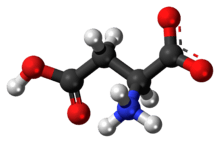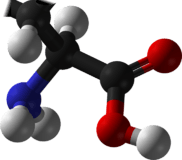Aspartic acid
 | |
 | |
| Names | |
|---|---|
| IUPAC names
Trivial: Aspartic acid Systematic: 2-Aminobutanedioic acid | |
| Other names
Aminosuccinic acid, asparagic acid, asparaginic acid[1] | |
| Identifiers | |
| 617-45-8 56-84-8 (L-isomer) 1783-96-6 (D-isomer) | |
| 3D model (Jmol) | Interactive image Interactive image |
| ChEBI | CHEBI:22660 |
| ChEMBL | ChEMBL139661 |
| ChemSpider | 411 |
| ECHA InfoCard | 100.000.265 |
| EC Number | 200-291-6 |
| KEGG | C16433 |
| PubChem | 424 |
| UNII | 28XF4669EP |
| |
| |
| Properties | |
| C4H7NO4 | |
| Molar mass | 133.10 g·mol−1 |
| Appearance | colourless crystals |
| Density | 1.7 g/cm3 |
| Melting point | 270 °C (518 °F; 543 K) |
| Boiling point | 324 °C (615 °F; 597 K) (decomposes) |
| 4.5 g/L[2] | |
| Acidity (pKa) | 3.9 |
| Hazards | |
| Safety data sheet | See: data page |
| NFPA 704 | |
| Supplementary data page | |
| Refractive index (n), Dielectric constant (εr), etc. | |
| Thermodynamic data |
Phase behaviour solid–liquid–gas |
| UV, IR, NMR, MS | |
| Except where otherwise noted, data are given for materials in their standard state (at 25 °C [77 °F], 100 kPa). | |
| | |
| Infobox references | |
Aspartic acid (abbreviated as Asp or D; encoded by the codons [GAU and GAC]), also known as aspartate, is an α-amino acid that is used in the biosynthesis of proteins. It contains an α-amino group (which is in the protonated −NH+
3 form under biological conditions), an α-carboxylic acid group (which is in the deprotonated −COO− form under biological conditions), and a side chain CH2COOH. Under physiological conditions in proteins the sidechain usually occurs as the negatively charged aspartate form, −COO−. It is semi-essential in humans, meaning the body can synthesize it from oxaloacetate.
In proteins aspartate sidechains are often hydrogen bonded, often as asx turns or asx motifs, which often occur at the N-termini of alpha helices.
Asp's L-isomer is one of the 23 proteinogenic amino acids, i.e., the building blocks of proteins. Asp (and glutamic acid) is classified as acidic, with a pKa of 3.9, however in a peptide this is highly dependent on the local environment (as with all amino acids), and could be as high as 14. Asp is pervasive in biosynthesis.
L-aspartic acid is one of the two main ingredients of the artificial sweetener aspartame, along with L-phenylalanine.
Discovery
Aspartic acid was first discovered in 1827 by Auguste-Arthur Plisson and Étienne Ossian Henry,[3] derived from asparagine, which had been isolated from asparagus juice in 1806, by boiling with a base.[4]
Forms and nomenclature
There are two forms or enantiomers of aspartic acid. The name "aspartic acid" can refer to either enantiomer or a mixture of two.[5] Of these two forms, only one, "L-aspartic acid", is directly incorporated into proteins. The biological roles of its counterpart, "D-aspartic acid" are more limited. Where enzymatic synthesis will produce one or the other, most chemical syntheses will produce both forms, "DL-aspartic acid," known as a racemic mixture.
Metabolism
Aspartate is non-essential in mammals, being produced from oxaloacetate by transamination. It can also be generated from ornithine and citrulline in the urea cycle. In plants and microorganisms, aspartate is the precursor to several amino acids, including four that are essential for humans: methionine, threonine, isoleucine, and lysine. The conversion of aspartate to these other amino acids begins with reduction of aspartate to its "semialdehyde," O2CCH(NH2)CH2CHO.[6] Asparagine is derived from aspartate via transamidation:
- -O2CCH(NH2)CH2CO2- + GC(O)NH3+ O2CCH(NH2)CH2CONH3+ + GC(O)O
(where GC(O)NH2 and GC(O)OH are glutamine and glutamic acid, respectively)
Other biochemical roles
Aspartate is also a metabolite in the urea cycle and participates in gluconeogenesis. It carries reducing equivalents in the malate-aspartate shuttle, which utilizes the ready interconversion of aspartate and oxaloacetate, which is the oxidized (dehydrogenated) derivative of malic acid. Aspartate donates one nitrogen atom in the biosynthesis of inosine, the precursor to the purine bases. In addition, aspartic acid acts as hydrogen acceptor in a chain of ATP synthase.
Interactive pathway map
Click on genes, proteins and metabolites below to link to respective articles. [§ 1]
Glycolysis and Gluconeogenesis edit
- ↑ The interactive pathway map can be edited at WikiPathways: "GlycolysisGluconeogenesis_WP534".
Neurotransmitter
Aspartate (the conjugate base of aspartic acid) stimulates NMDA receptors, though not as strongly as the amino acid neurotransmitter L-glutamate does.[7]
Applications & Market
The global market for aspartic acid is $117MM annually (50-60K MT/Yr)[8] with areas of growth accounting for an addressable market of $8.78BB.[9] The three largest market segments include the U.S., Western Europe, and China. Current applications include biodegradable polymers (polyaspartate), low calorie sweeteners, scale and corrosion inhibitors, and resins.
Nearly all aspartic acid is manufactured in China.
Superabsorbent polymers
One area of aspartic acid market growth is biodegradable superabsorbent polymers (SAP). The super absorbent polymers market is anticipated to grow at a CAGR of 5.5% from 2014 to 2019 to reach a value of $8.78BB globally.[9] Around 75% of superabsorbent polymers are used in disposable diapers and an additional 20% is used for adult incontinence and feminine hygiene products. Polyaspartate, the polymerization product of aspartic acid, is a biodegradable substitute to polyacrylate.[10] The polyaspartate market comprises a small fraction (est. < 1%) of the total SAP market.
Additional uses
In addition to SAP, aspartic acid has applications in the $19B fertilizer industry, where polyaspartate improves water retention and nitrogen uptake;[11] the $1.1B (2020) concrete floor coatings market, where polyaspartic is a low VOC, low energy alternative to traditional epoxy resins;[12] and lastly the >$5B scale and corrosion inhibitors market.[13]
- Aspartic acid is known to have a use in the synthesis of Lorglumide.
Sources
Dietary sources
Aspartic acid is not an essential amino acid, which means that it can be synthesized from central metabolic pathway intermediates in humans. Aspartic acid is found in:
- Animal sources: oysters, luncheon meats, sausage meat, wild game
- Vegetable sources: sprouting seeds, oat flakes, avocado,[14] asparagus,[15] young sugarcane, and molasses from sugar beets.[1]
- Dietary supplements, either as aspartic acid itself or salts (such as magnesium aspartate)
- The sweetener aspartame (brands: NutraSweet, Equal, Canderel, etc.)
Chemical synthesis
Racemic aspartic acid can be synthesized from diethyl sodium phthalimidomalonate, (C6H4(CO)2NC(CO2Et)2).[16]
The major disadvantage of the above technique is that equimolar amounts of each enantiomer are made. Using biotechnology it is now possible to use immobilised enzymes to create just one type of enantiomer owing to their stereospecificity.
See also
References
- 1 2 "862. Aspartic acid". The Merck Index (11th ed.). 1989. p. 132. ISBN 0-911910-28-X.
- ↑ "ICSC 1439 - L-ASPARTIC ACID". inchem.org.
- ↑ Berzelius, Jöns Jakob; Öngren, Olof Gustaf (1839). Traité de chimie (in French). 3. Brussels: A. Wahlen et Cie. p. 81. Retrieved 25 August 2015.
- ↑ R.H.A. Plimmer (1912) [1908]. R.H.A. Plimmer & F.G. Hopkins, ed. The chemical composition of the proteins. Monographs on biochemistry. Part I. Analysis (2nd ed.). London: Longmans, Green and Co. p. 112. Retrieved January 18, 2010.
- ↑ "Nomenclature and symbolism for amino acids and peptides (IUPAC-IUB Recommendations 1983)", Pure Appl. Chem., 56 (5): 595–624, 1984, doi:10.1351/pac198456050595.
- ↑ Lehninger, Albert L.; Nelson, David L.; Cox, Michael M. (2000), Principles of Biochemistry (3rd ed.), New York: W. H. Freeman, ISBN 1-57259-153-6.
- ↑ Chen, Philip E.; Geballe, Matthew T.; Stansfeld, Phillip J.; Johnston, Alexander R.; Yuan, Hongjie; Jacob, Amanda L.; Snyder, James P.; Traynelis, Stephen F.; Wyllie, David J. A. (2005). "Structural Features of the Glutamate Binding Site in Recombinant NR1/NR2A N-Methyl-D-aspartate Receptors Determined by Site-Directed Mutagenesis and Molecular Modeling". Mol. Pharmacol. 67 (5): 1470–84. doi:10.1124/mol.104.008185. PMID 15703381.
- ↑ Evans, J. in Commercial Amino Acids 101–103 (BCC Research, 2014).
- 1 2 Transparency Market Research. Superabsorbent polymers market - global industry analysis, size, share, growth, trends and forecase, 2014-2020. (2014).
- ↑ Alford, D. D., Wheeler, A. P. & Pettigrew, C. A. Biodegradation of thermally synthesized polyaspartate. J Environ Polym Degr 2, 225–236 (1994).
- ↑ Kelling, K. Crop Responses to Amisorb in the North Central Region. (University of Wisconsin-Madison, 2001).
- ↑ Global concrete floor coatings market will be worth US$1.1 bn by 2020. Transparency Market Research (2015).
- ↑ Corrosion inhibitors market analysis by product, by application, by end-use industry, and segment forecasts to 2020. Grand View Research (2014)
- ↑ D. K. Salunkhe; S.S. Kadam (18 August 1995). Handbook of Fruit Science and Technology: Production, Composition, Storage, and Processing. CRC Press. pp. 368–. ISBN 978-0-8247-9643-3.
- ↑ Douglas M. Considine (6 December 2012). Foods and Food Production Encyclopedia. Springer Science & Business Media. pp. 114–. ISBN 978-1-4684-8511-0.
- ↑ Dunn, M. S.; Smart, B. W. (1950). "DL-Aspartic Acid". Org. Synth. 30: 7.; Coll. Vol., 4, p. 55.
External links
- GMD MS Spectrum
- American Chemical Society (21 April 2010). "Ancestral Eve' Crystal May Explain Origin of Life's Left-Handedness". ScienceDaily. Archived from the original on 23 April 2010. Retrieved 2010-04-21.


